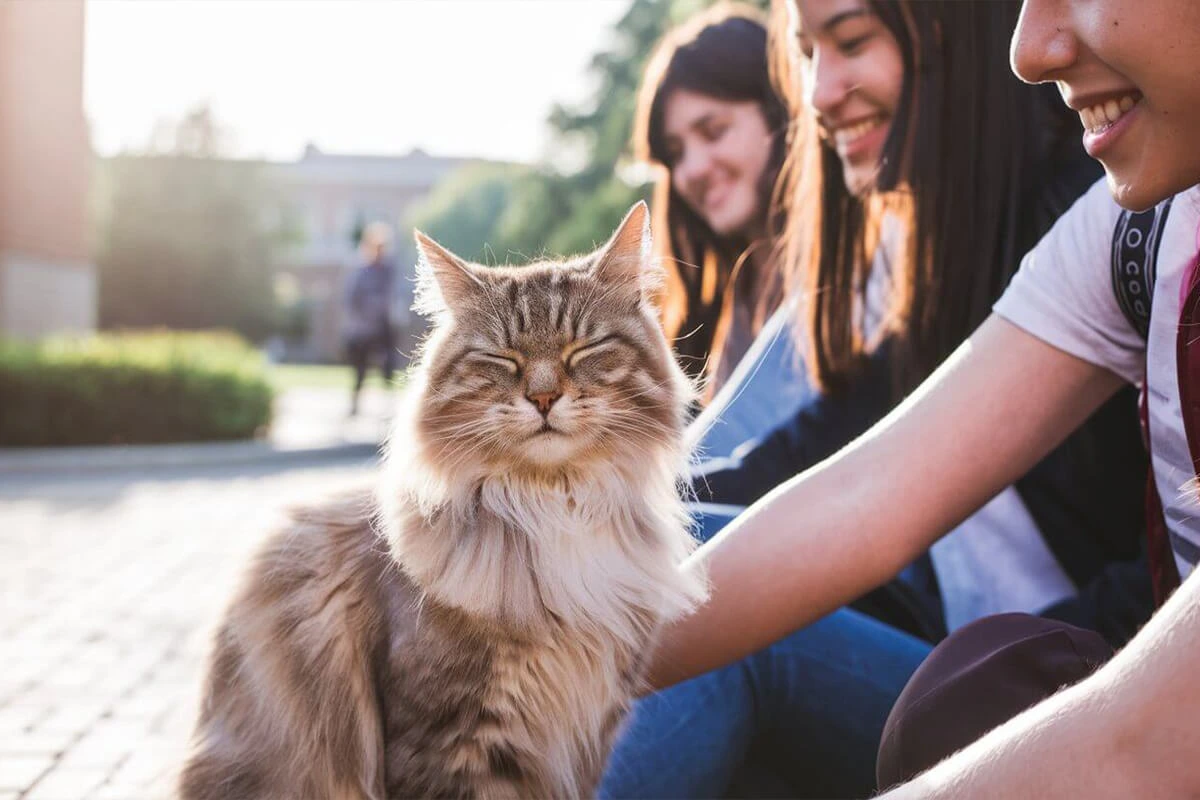Cafeteria Cat isn’t just another stray wandering a college campus—this furry feline has captured the hearts of students, staff, and social media users alike. What started as a simple case of a stray cat looking for food near the campus dining hall quickly turned into a heartwarming story of companionship, kindness, and community.
Every day, students line up for lunch, and right outside, a familiar furry friend greets them with soft purrs and an affectionate nuzzle. Some offer treats, others stop for a quick cuddle, but everyone agrees—Cafeteria Cat has become an irreplaceable part of campus life.
This blog post takes you through the journey of Cafeteria Cat, from a stray looking for scraps to a beloved campus icon. You’ll discover how this friendly feline won over an entire university, achieved social media fame, and even sparked discussions about pet adoption and campus mascots. Get ready for a feel-good story about how one small cat made a big impact.
The Origins of Cafeteria Cat: A Stray’s Journey to Campus
How Cafeteria Cat Was First Spotted Near the Dining Hall
Cafeteria Cat didn’t just appear out of nowhere. One day, students noticed a small, scruffy feline lingering near the dining hall, cautiously sniffing the air as the scent of food filled the area. Some students saw the cat darting between tables on the outdoor patio, while others spotted it hiding under benches, watching from a safe distance. The cat didn’t approach people right away, but hunger kept bringing it back.
At first, only a few students paid attention. Some left scraps of food behind, hoping the little visitor would come closer. Slowly but surely, the cat grew bolder, inching toward friendly hands that offered small bits of chicken or fish. Word spread quickly—there was a new furry guest at the cafeteria, and it had no plans of leaving.
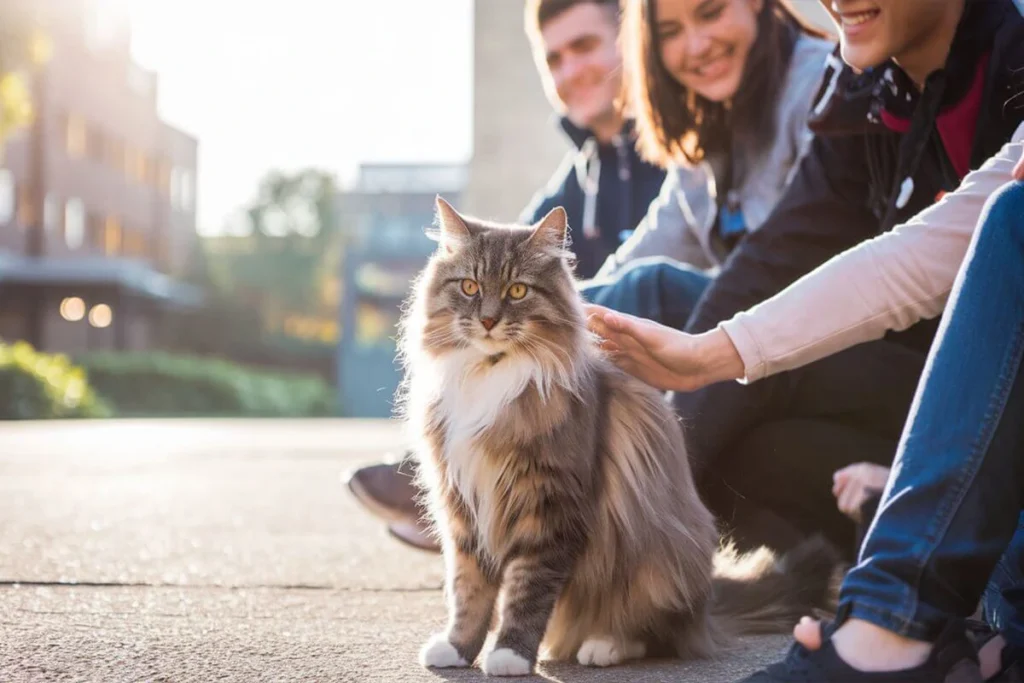
Early Encounters with Students and Staff
Curiosity led more students to seek out the mysterious cat. Some snapped pictures, while others tried to get close enough for a gentle pet. The cat, at first cautious, soon realized that these humans meant no harm. A few students even started bringing small treats just for their new feline friend, encouraging it to return every day.
Dining hall staff took notice, too. Some smiled as they watched students interact with the cat, while others occasionally left a small bowl of water near the back entrance. One cafeteria worker, known for her love of animals, even started calling the cat “Cafeteria Cat,” a name that stuck as more people started referring to it that way.
The cat’s charm worked like magic. Its playful antics, soft purrs, and big, curious eyes melted hearts across campus. Some students made it a daily routine to visit the dining hall just to check on their new furry friend.
The Challenges of Life as a Stray Cat Before Finding a Home on Campus
Before Cafeteria Cat became a campus favorite, life as a stray wasn’t easy. With no permanent shelter, the cat had to find safe places to sleep, often curling up under benches, inside bushes, or beneath stairwells to stay warm. Rainy days meant cold, damp fur, and winter nights brought harsh winds that tested its resilience.
Food never came easily. Some days, the cat got lucky when students left behind scraps. Other times, it had to scavenge through trash cans, searching for anything edible. Competing with other strays—both cats and sometimes aggressive birds—added another challenge.
Despite these hardships, the cat’s determination kept it coming back to the cafeteria. It learned to recognize friendly faces and developed a routine that kept it safe. Little did it know, its persistence would soon turn into something much bigger—a new home filled with love, care, and an entire community that welcomed it with open arms.
How Cafeteria Cat Won Over Students and Staff
The Cat’s Charming Personality and Interactions with People
Cafeteria Cat didn’t just survive on campus—it thrived, thanks to its irresistible charm and friendly nature. Unlike many stray cats that remain skittish around humans, this feline showed an unusual level of confidence and curiosity. Instead of hiding in the shadows, it walked right up to students, rubbing against their legs and meowing softly for attention.
Students couldn’t resist. They crouched down to scratch behind its ears, laughed at its playful swats at dangling shoelaces, and even took selfies with their newfound furry friend. Cafeteria Cat had a way of making people feel special. It chose specific students to follow, plopped down beside them while they ate, and sometimes even climbed onto their laps as if they were old friends.
Staff members also fell for its charm. Some playfully scolded it when it tried to sneak into the dining hall, while others greeted it like an old coworker. The cat had an undeniable ability to lift moods, turning stressful school days into moments of joy with just a flick of its tail.
Daily Visits to the Cafeteria and Friendly Behavior
Cafeteria Cat quickly developed a routine. Every morning, it showed up outside the dining hall, stretching lazily as students made their way to breakfast. Some greeted it with soft head pats, while others came prepared with small treats tucked inside their backpacks.
By lunchtime, the cat had secured its favorite spot—either near the cafeteria entrance or on a sunny bench where students gathered. It weaved between tables, accepting gentle pets and occasionally hopping onto empty chairs like it was part of the lunch crew. Instead of begging aggressively for food, it mastered the art of the slow, patient stare—the kind that made people willingly share a few bites from their plates.
In the evenings, Cafeteria Cat became even more social. As students unwound from classes, it lounged beside them, soaking in the warmth of their company. Some students swore it could sense when someone was having a rough day because it always seemed to curl up beside those who needed comfort the most.
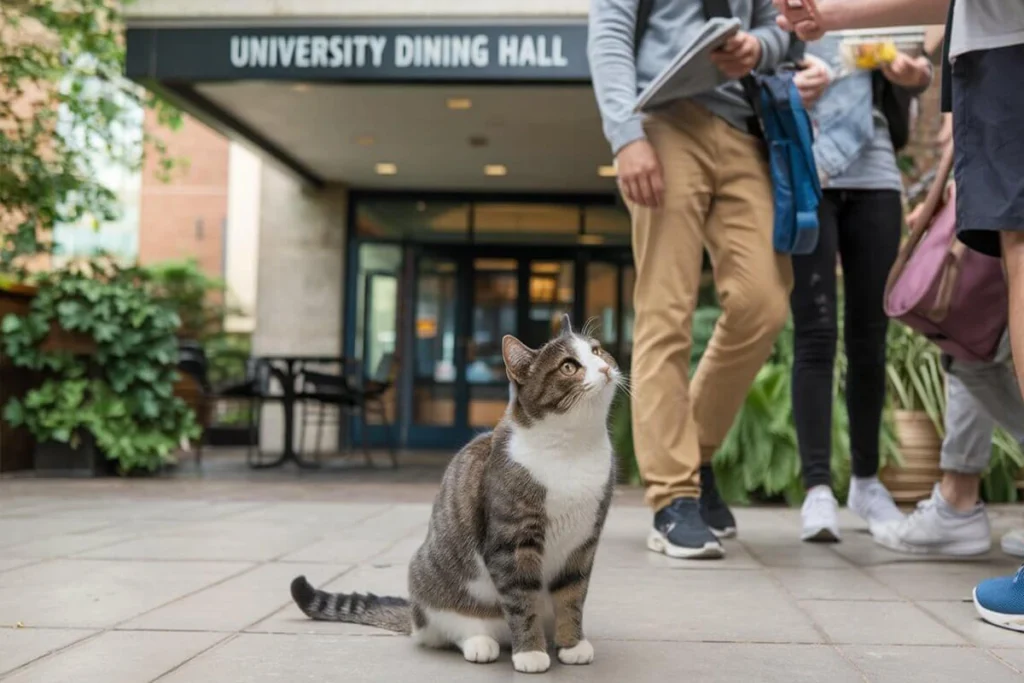
How the University Community Started Caring for the Cat
At first, Cafeteria Cat’s presence felt like a happy coincidence, but before long, the entire campus took an active role in its well-being. Students formed an unofficial care team, bringing food, setting out water bowls, and ensuring it had a warm place to rest at night. Some even pooled money to buy cat treats and a cozy bed, which they placed in a quiet corner near the cafeteria entrance.
Faculty and staff joined in, too. A few professors mentioned the cat in their lectures, jokingly calling it an “honorary student.” Security guards looked out for its safety, making sure it wasn’t disturbed by large crowds or aggressive animals. Even the cafeteria workers, who once shooed it away from the doors, started leaving out small portions of cat-friendly food in discreet spots.
As Cafeteria Cat became a true part of campus life, discussions about its future began. Some students wanted to officially adopt it as the university’s mascot, while others suggested working with local rescue organizations to ensure its long-term safety. Regardless of what happened next, one thing was clear—this once-hungry stray had found more than just food on campus. It had found a family.
Social Media Fame: The Viral Story of Cafeteria Cat
Students Sharing Photos and Videos Online
The moment Cafeteria Cat started making regular appearances near the dining hall, students couldn’t resist documenting their interactions. At first, a few people snapped casual photos, sharing them in group chats with captions like, “Look who joined me for lunch today!” But as more students noticed the cat’s friendly and playful nature, social media platforms flooded with adorable pictures and short videos.
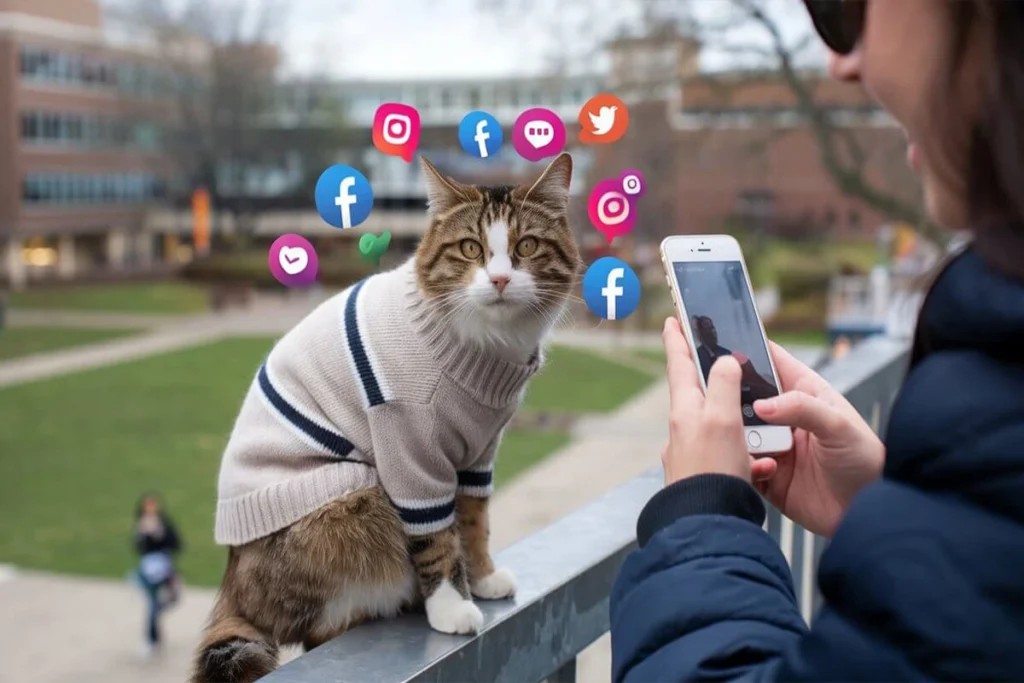
One student captured a video of Cafeteria Cat confidently strutting across the quad, tail held high, like it owned the place. Another recorded a hilarious clip of the cat attempting to “help” with homework by sitting directly on an open textbook. A particularly heartwarming post showed Cafeteria Cat curling up next to a stressed-out student who was studying for finals, purring softly as if offering moral support.
Before long, students began tagging their posts with hashtags like #CafeteriaCat, #CampusKitty, and #CollegeMascotCat to keep track of the growing collection of content. The more people posted, the more others on campus wanted to meet the cat in person. Cafeteria Cat wasn’t just a local favorite anymore—it was turning into a campus celebrity.
The Role of Social Media in Making the Cat Famous
Social media didn’t just spread Cafeteria Cat’s fame across campus—it helped it reach far beyond university grounds. Students started posting TikToks featuring the cat’s daily antics, from its charming head tilts to its adorable habit of pawing at students for attention. Instagram stories featured Cafeteria Cat lounging in the sun, chasing leaves, or waiting patiently outside the cafeteria doors like it had an official reservation.
Twitter and Reddit also played a role in boosting the cat’s popularity. One viral tweet, featuring a photo of Cafeteria Cat staring longingly at a student’s sandwich, racked up thousands of likes with the caption, “He doesn’t even go here, but he’s part of the family now.” Another student posted a before-and-after picture showing how the once-scrawny stray had transformed into a well-fed, confident campus king.
Alumni and students from other universities started commenting, sharing their own campus pet stories and wishing they had a Cafeteria Cat of their own. Some even joked that the university should give the cat an honorary degree. Thanks to social media, this once-unknown stray had become a viral sensation, bringing people together in the process.
How the Internet Turned Cafeteria Cat into a College Mascot
As the online buzz grew, Cafeteria Cat’s status on campus became undeniable. Students affectionately referred to it as the “unofficial mascot,” and some even designed custom stickers and T-shirts featuring its face. Someone edited the university’s Wikipedia page, adding “Cafeteria Cat” under notable figures. A graphic design student created a mock logo featuring the cat’s silhouette next to the school’s emblem, and before long, people were printing it on water bottles and laptop stickers.
Student organizations started incorporating Cafeteria Cat into their events. One club hosted a “Study with Cafeteria Cat” session, encouraging students to gather outside the cafeteria for a relaxing study break. Another group designed a Cafeteria Cat-themed scavenger hunt, where students could win prizes by spotting the feline at different campus locations.
The university administration couldn’t ignore the cat’s growing fame. Some professors referenced it in lectures, jokingly calling it the “most popular student on campus.” Even official university social media accounts got in on the fun, posting pictures with captions like, “Our most dedicated diner—Cafeteria Cat never misses a meal!”
At this point, Cafeteria Cat had become more than just a stray. It had become a symbol of the university’s warmth and community spirit. Whether through in-person interactions or online engagement, this little feline had found a way to unite an entire campus.
The Impact of Cafeteria Cat on Campus Life
How the Cat Brought Joy and Comfort to Students
Cafeteria Cat didn’t just roam the campus looking for food—it became a source of happiness and emotional support for students. College life often feels overwhelming, with endless assignments, exams, and deadlines piling up. But no matter how stressful the day felt, a simple encounter with Cafeteria Cat could instantly lift someone’s mood.
Students loved the way the cat greeted them with soft purrs and playful nudges. Some sat beside it during lunch breaks, finding comfort in its calm presence. Others simply enjoyed watching it chase leaves, roll around in the grass, or nap in the sun. The cat had an uncanny ability to sense when someone needed company, often curling up beside students who looked particularly tired or stressed.
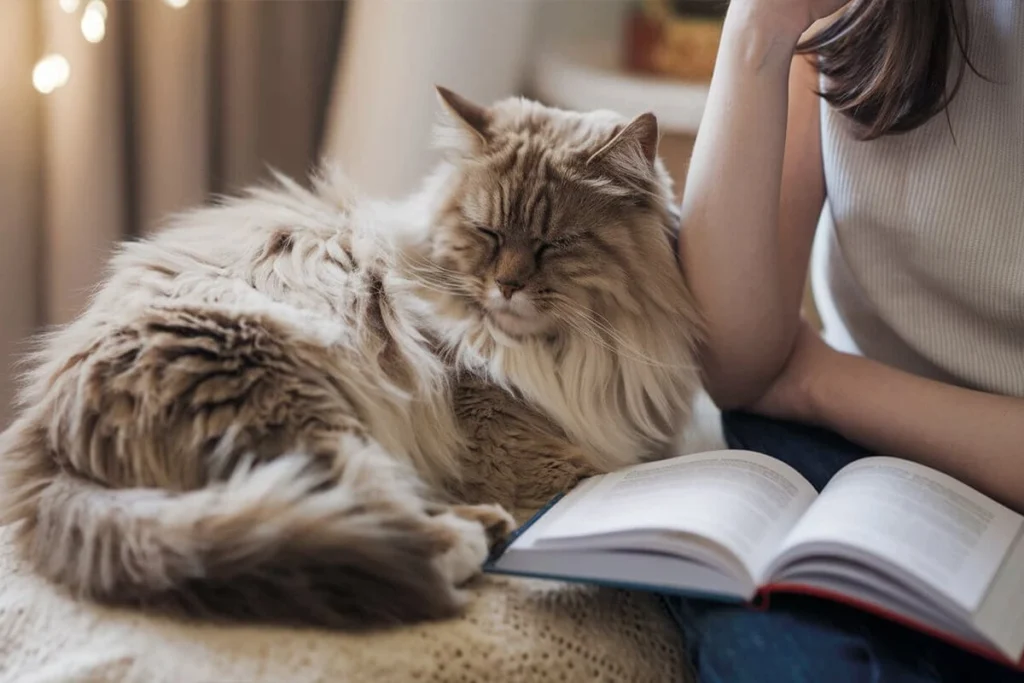
Laughter echoed across the quad whenever Cafeteria Cat did something silly, like sneaking into backpacks or jumping onto benches like it owned the place. It wasn’t just a stray anymore—it had become a small but meaningful part of everyone’s daily life.
Cafeteria Cat as a Stress Reliever During Exams
During exam season, the campus atmosphere changed. Students walked around with tired eyes, stress levels skyrocketed, and the dining hall filled with anxious conversations about test questions and essay deadlines. But even in the middle of all that pressure, Cafeteria Cat continued to work its magic.
Many students made a habit of visiting the cat during study breaks, using those brief moments of petting and play as a way to relax. Some even joked that spending time with the cat improved their focus more than any caffeine-fueled all-nighter ever could.
One group of students set up a “Cafeteria Cat Study Corner,” where they gathered outside the dining hall to prepare for exams, hoping the cat would join them. Sure enough, the cat often settled among the books and laptops, offering quiet companionship as students worked through their notes.
University staff also recognized the cat’s positive impact. Some professors encouraged students to take “Cafeteria Cat breaks” between long study sessions. Even the library staff acknowledged the feline’s stress-relieving presence, putting up a lighthearted sign that read, “Feeling overwhelmed? Take a deep breath and go say hi to Cafeteria Cat!”
The University Embracing the Cat as an Unofficial Mascot
As Cafeteria Cat’s influence grew, it became impossible to ignore. Students, staff, and even faculty members had embraced it as an essential part of campus culture.
The student government proposed an initiative to make Cafeteria Cat the official campus pet, ensuring it received proper care and protection. A group of volunteers worked together to provide regular food and veterinary check-ups, making sure the cat stayed healthy. Some departments even incorporated the cat into university traditions—one club designed a “Cafeteria Cat” T-shirt for incoming freshmen, while another featured the cat in a year-end slideshow celebrating campus life.
University social media accounts started posting about Cafeteria Cat, sharing fun facts and updates on its daily activities. The marketing team even joked about adding the cat to the school’s promotional materials. “Why choose our university?” one post read. “Beautiful campus, great academic programs, and—most importantly—a friendly feline to brighten your day!”
By this point, Cafeteria Cat was more than just a stray—it was a symbol of warmth, resilience, and community spirit. No one knew exactly how long it would stay, but one thing was certain: this once-hungry cat had found a home, and the university had gained a furry, four-legged mascot that would be remembered for years to come.
What’s Next for Cafeteria Cat? Adoption and Future Plans
Talks of Adoption or Official Care by the University
As Cafeteria Cat’s presence on campus became undeniable, students and faculty began discussing its long-term care. While the cat seemed happy roaming freely, many worried about its safety, especially during extreme weather or school breaks when fewer people were around to feed it. Conversations about making Cafeteria Cat an official part of the university started circulating among student organizations, faculty members, and even administration staff.
Some students suggested that the university adopt the cat as an official campus pet, providing it with permanent shelter, food, and veterinary care. Others proposed working with local animal welfare groups to ensure the cat had proper vaccinations and regular check-ups. A few even volunteered to create a Cafeteria Cat Care Committee, which would oversee its well-being and coordinate feeding schedules.
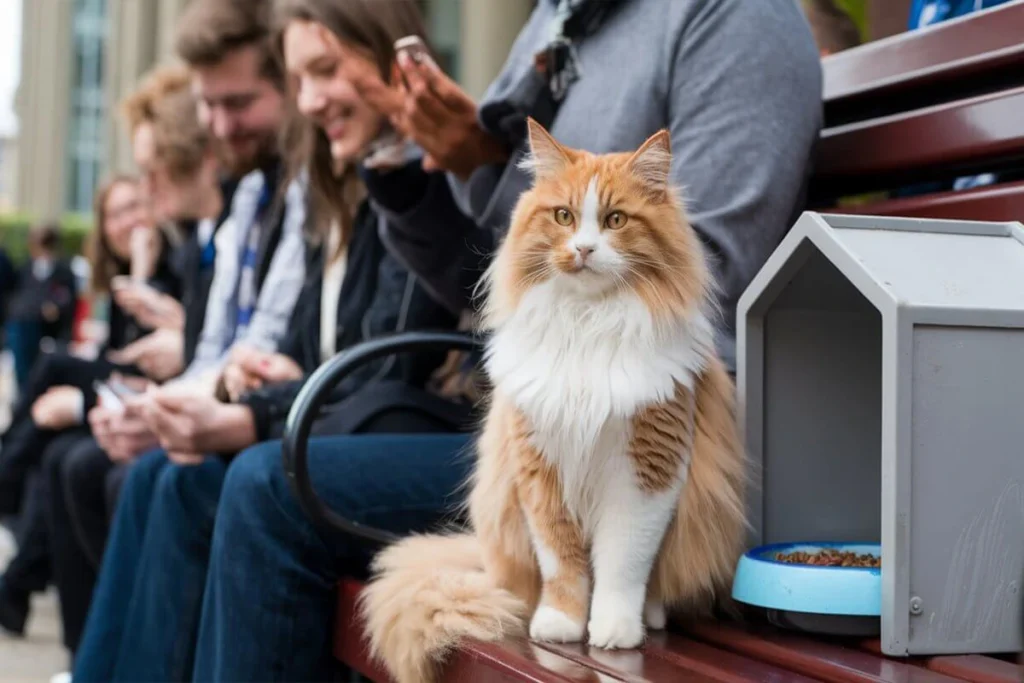
The administration took notice. While some officials initially hesitated, concerned about liability and long-term responsibility, they couldn’t ignore how much the cat meant to the students. University representatives met with student groups to explore different options, from setting up a designated shelter near the dining hall to partnering with local rescue organizations to ensure the cat’s continued care.
Efforts to Ensure the Cat’s Health and Safety
Once discussions about Cafeteria Cat’s care became serious, students and staff took immediate steps to improve its quality of life. Instead of relying on scraps and handouts, some students brought proper cat food, leaving bowls in safe, shaded spots. A group of animal-loving faculty members chipped in to fund veterinary check-ups, ensuring the cat received vaccinations, flea treatments, and a general health assessment.
To provide shelter, students set up small, insulated cat houses in discreet areas around the dining hall. These shelters protected Cafeteria Cat from rain, wind, and cold temperatures, giving it a safe place to rest. University security guards also played a role in monitoring the cat’s safety, making sure it wasn’t disturbed by aggressive animals or well-meaning but overly enthusiastic visitors.
One student even started a social media account dedicated to Cafeteria Cat, updating followers on its health, daily activities, and any upcoming events related to its care. The account gained a strong following, helping spread awareness about responsible animal care and inspiring donations from alumni who wanted to support the cat’s well-being.
How Cafeteria Cat’s Story Inspires Other Campuses to Help Stray Animals
Cafeteria Cat’s journey from stray to beloved campus figure didn’t just impact the university—it inspired students from other schools to take action for stray animals on their own campuses. As social media posts about the cat went viral, students from different universities started sharing their own experiences with campus cats, stray dogs, and other animals in need.
Some schools already had informal pet-friendly policies, but Cafeteria Cat’s story encouraged them to create structured programs for feeding, sheltering, and caring for stray animals. Student-led animal welfare clubs gained traction, organizing fundraising events, adoption drives, and educational campaigns to promote responsible pet care.
Local animal rescues also took notice. Some partnered with universities to provide vaccinations and sterilization programs for stray animals, ensuring healthier and safer communities for both people and pets. Inspired by Cafeteria Cat, a few schools even designated official “Campus Pets”—strays that had found a permanent home within their college grounds.
What started as a simple act of kindness—feeding a stray cat outside a cafeteria—had turned into something much bigger. Cafeteria Cat’s story wasn’t just about one lucky feline; it was a reminder that small acts of compassion could create lasting change, bringing people together and improving the lives of animals in need.
Conclusion
Cafeteria Cat’s journey from a lonely stray to a beloved campus icon proves that a simple act of kindness can create lasting ripples. What began as a hungry feline searching for scraps outside the dining hall quickly turned into a heartwarming story of compassion, connection, and community. Students, faculty, and staff didn’t just tolerate the cat’s presence—they embraced it, making it a cherished part of daily campus life.
Beyond providing food and shelter, the university community gave Cafeteria Cat something even more valuable: a sense of belonging. The cat’s playful interactions, comforting presence, and endearing personality brought people together, offering stress relief during tough academic moments and spreading joy with every soft purr and curious head tilt. Its story reached far beyond campus, inspiring other universities to care for stray animals and proving that a small, furry visitor could make a big impact.
As Cafeteria Cat continues to roam its favorite spots, lounging in the sun and greeting students with its familiar charm, its legacy remains strong. Whether through social media fame, student-led initiatives, or official campus recognition, the cat has left an indelible mark on the university. Its story reminds everyone that kindness matters, that even the smallest creatures deserve love, and that sometimes, the most unexpected friendships can become the most meaningful.
Cafeteria Cat may have started as a stray, but it will always be part of the campus family—a symbol of warmth, resilience, and the unbreakable bond between humans and animals.
Discover More About Cats and Breeds Over Here!
You Can Find Good stuff for your Furry Friend on Pet MD Official
